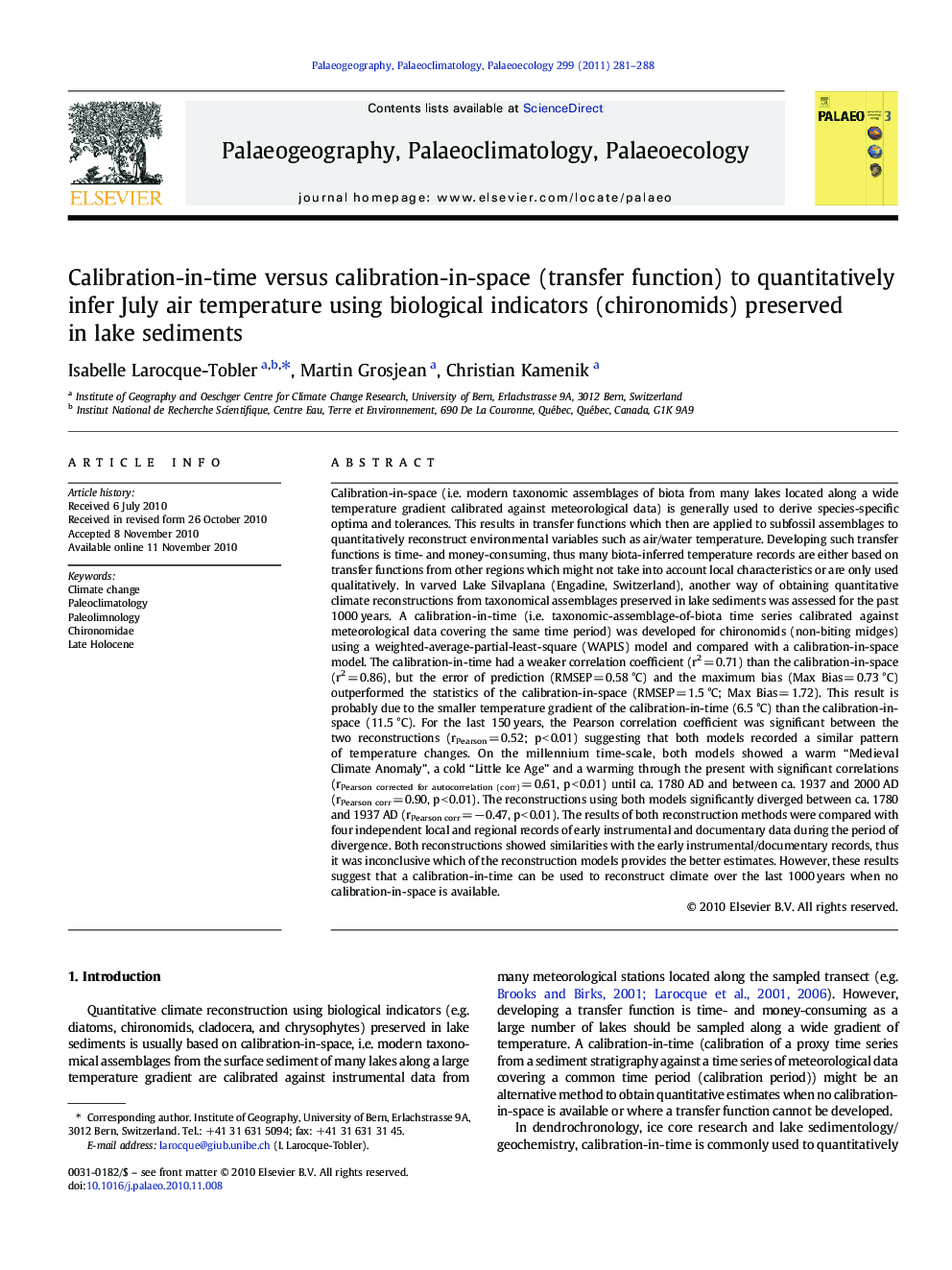| کد مقاله | کد نشریه | سال انتشار | مقاله انگلیسی | نسخه تمام متن |
|---|---|---|---|---|
| 6350700 | 1622265 | 2011 | 8 صفحه PDF | دانلود رایگان |
عنوان انگلیسی مقاله ISI
Calibration-in-time versus calibration-in-space (transfer function) to quantitatively infer July air temperature using biological indicators (chironomids) preserved in lake sediments
دانلود مقاله + سفارش ترجمه
دانلود مقاله ISI انگلیسی
رایگان برای ایرانیان
کلمات کلیدی
موضوعات مرتبط
مهندسی و علوم پایه
علوم زمین و سیارات
فرآیندهای سطح زمین
پیش نمایش صفحه اول مقاله

چکیده انگلیسی
Calibration-in-space (i.e. modern taxonomic assemblages of biota from many lakes located along a wide temperature gradient calibrated against meteorological data) is generally used to derive species-specific optima and tolerances. This results in transfer functions which then are applied to subfossil assemblages to quantitatively reconstruct environmental variables such as air/water temperature. Developing such transfer functions is time- and money-consuming, thus many biota-inferred temperature records are either based on transfer functions from other regions which might not take into account local characteristics or are only used qualitatively. In varved Lake Silvaplana (Engadine, Switzerland), another way of obtaining quantitative climate reconstructions from taxonomical assemblages preserved in lake sediments was assessed for the past 1000 years. A calibration-in-time (i.e. taxonomic-assemblage-of-biota time series calibrated against meteorological data covering the same time period) was developed for chironomids (non-biting midges) using a weighted-average-partial-least-square (WAPLS) model and compared with a calibration-in-space model. The calibration-in-time had a weaker correlation coefficient (r2 = 0.71) than the calibration-in-space (r2 = 0.86), but the error of prediction (RMSEP = 0.58 °C) and the maximum bias (Max Bias = 0.73 °C) outperformed the statistics of the calibration-in-space (RMSEP = 1.5 °C; Max Bias = 1.72). This result is probably due to the smaller temperature gradient of the calibration-in-time (6.5 °C) than the calibration-in-space (11.5 °C). For the last 150 years, the Pearson correlation coefficient was significant between the two reconstructions (rPearson = 0.52; p < 0.01) suggesting that both models recorded a similar pattern of temperature changes. On the millennium time-scale, both models showed a warm “Medieval Climate Anomaly”, a cold “Little Ice Age” and a warming through the present with significant correlations (rPearson corrected for autocorrelation (corr) = 0.61, p < 0.01) until ca. 1780 AD and between ca. 1937 and 2000 AD (rPearson corr = 0.90, p < 0.01). The reconstructions using both models significantly diverged between ca. 1780 and 1937 AD (rPearson corr = â0.47, p < 0.01). The results of both reconstruction methods were compared with four independent local and regional records of early instrumental and documentary data during the period of divergence. Both reconstructions showed similarities with the early instrumental/documentary records, thus it was inconclusive which of the reconstruction models provides the better estimates. However, these results suggest that a calibration-in-time can be used to reconstruct climate over the last 1000 years when no calibration-in-space is available.
ناشر
Database: Elsevier - ScienceDirect (ساینس دایرکت)
Journal: Palaeogeography, Palaeoclimatology, Palaeoecology - Volume 299, Issues 1â2, 1 January 2011, Pages 281-288
Journal: Palaeogeography, Palaeoclimatology, Palaeoecology - Volume 299, Issues 1â2, 1 January 2011, Pages 281-288
نویسندگان
Isabelle Larocque-Tobler, Martin Grosjean, Christian Kamenik,